Pricing Guides & Dictionary of Makers Marks for Antiques & Collectibles

COLLECTIBLE CARVED OKIMONOS:
How to Research and Value These Treasured Japanese Figurines
Join the most updated and complete collectibles research online - Learn more...
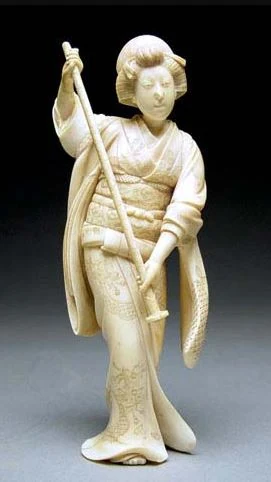 Okimonos are intricately carved Japanese figurines that have been prized for centuries for their beauty and craftsmanship. These collectible items come in various shapes and sizes and are made from a range of materials, including ivory, wood, bone, and jade. While they were initially created for practical purposes, such as being used as netsuke or toggles, they have since become highly sought-after by collectors all over the world.
Okimonos are intricately carved Japanese figurines that have been prized for centuries for their beauty and craftsmanship. These collectible items come in various shapes and sizes and are made from a range of materials, including ivory, wood, bone, and jade. While they were initially created for practical purposes, such as being used as netsuke or toggles, they have since become highly sought-after by collectors all over the world.
If you're interested in collecting carved Okimonos, it's important to research the different types available, their history, and how to value them. In this article, we'll explore the world of collectible carved Okimonos and provide you with tips on how to build your collection.
History of Carved Okimonos
The history of carved Okimonos can be traced back to the 17th century. During this time, Japanese artists began to create small, intricately carved figurines that were used as toggles or netsuke. These toggles were attached to the end of a cord, which was then attached to a container or pouch. The toggles prevented the container from slipping off the belt or sash.
As time went on, the use of toggles declined, and artists began to create Okimonos purely for decorative purposes. The figurines became more elaborate, with artists experimenting with different materials, including ivory, wood, bone, and jade.
Types of Carved Okimonos
There are several different types of carved Okimonos available. The most common types include:
- Netsuke - These are small, intricate figurines that were originally used as toggles. They were often carved from ivory or wood and featured a range of different designs, including animals, people, and mythical creatures.
- Inro - Inros were small, decorative boxes that were used to carry small items such as medicine or tobacco. They were often adorned with a netsuke, which was attached to the end of a cord that secured the inro to the wearer's sash.
- Ojime - Ojimes are small beads that were used to secure the cord that held the inro in place. They were often carved from bone or ivory and featured intricate designs.
- Okimono - Okimonos are decorative figurines that were created purely for their aesthetic value. They can be made from a range of materials, including ivory, wood, and bone.
Researching Carved Okimonos
When researching carved Okimonos, it's important to start by understanding the different types available and the materials they are made from. You should also research the history of carved Okimonos, including the different styles and techniques used by Japanese artists throughout the centuries.
One of the best ways to research carved Okimonos is to visit museums or art galleries that feature these collectible items. This will give you an opportunity to view different types of Okimonos up close and to learn about their history and cultural significance.
Another valuable resource for researching carved Okimonos is online forums and collector groups. These groups can provide you with valuable information about where to find these collectible items, how to identify fakes, and how to value your collection.
Valuing Carved Okimonos
Valuing carved Okimonos can be difficult, as there are many factors to consider, including the materials used, the condition of the item, and the rarity of the design. One of the most important factors in determining the value of a carved Okimono is the material it is made from. Ivory Okimonos are typically the most valuable, followed by those made from bone or jade.
Condition is also an important factor in determining the value of a carved Okimono. Collectors will typically pay more for pieces that are in excellent condition with no cracks or chips. If an Okimono has been repaired, its value may be significantly lower than a piece in its original condition.
Another important factor in valuing carved Okimonos is the rarity of the design. Some designs may be more sought after than others, and collectors may be willing to pay a premium for rare or unusual Okimonos.
When determining the value of a carved Okimono, it's important to consult with experts in the field. This could include art dealers, auction houses, or specialist collectors. These experts can provide you with valuable information about the current market for carved Okimonos and help you to determine a fair value for your collection.
Building a Collection of Carved Okimonos
Building a collection of carved Okimonos can be a rewarding hobby, but it's important to take your time and do your research before making any purchases. Here are some tips to help you build a collection of carved Okimonos:
- Start small - If you're new to collecting carved Okimonos, it's a good idea to start small and build your collection gradually. This will give you a chance to learn about the different types of Okimonos available and to develop your eye for quality.
- Learn about the different materials - As we mentioned earlier, the materials used to make carved Okimonos can have a significant impact on their value. Take the time to learn about the different materials, their properties, and how to identify them.
- Join a collector group - Joining a collector group can provide you with valuable information about where to find carved Okimonos, how to identify fakes, and how to value your collection. It can also be a great way to connect with other collectors who share your passion for these beautiful figurines.
- Consult with experts - If you're serious about building a collection of carved Okimonos, it's important to consult with experts in the field. They can provide you with valuable information about the current market for these collectibles and help you to determine the value of your collection.
In conclusion, carved Okimonos are beautiful and highly collectible Japanese figurines that have been treasured for centuries. If you're interested in collecting these items, it's important to do your research, learn about the different types available, and consult with experts in the field. With patience and a keen eye for quality, you can build a collection of carved Okimonos that will be both beautiful and valuable.
Unlock the true value of your collection with our comprehensive research guides from identifying makers' marks to appraising all kinds of antiques and collectibles, including items featured in this article.
Our up-to-date information will give you an accurate understanding of your items' worth. Don't miss out on this valuable resource - visit our research tools today!
In addition to some examples shown below on this page, you can also search our price guide for your own treasures.
Examples of related items from our Price Guides
-
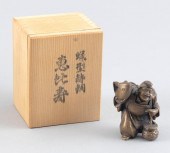 JAPANESE BRONZE OKIMONO OF EBISU 20TH CE
[more like this]
JAPANESE BRONZE OKIMONO OF EBISU 20TH CE
[more like this]
-
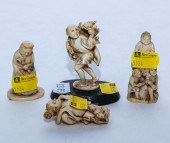 FOUR JAPANESE CARVED OKIMONO & NETSUKE 1
[more like this]
FOUR JAPANESE CARVED OKIMONO & NETSUKE 1
[more like this]
-
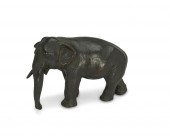 A JAPANESE OKIMONO BRONZE ELEPHANTA Japa
[more like this]
A JAPANESE OKIMONO BRONZE ELEPHANTA Japa
[more like this]
-
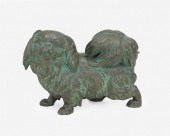 A JAPANESE MARUKI BRONZE OKIMONO OF A CH
[more like this]
A JAPANESE MARUKI BRONZE OKIMONO OF A CH
[more like this]
-
 5 IVORY OKIMONO AND NETSUKE FIGURES5 Car
[more like this]
5 IVORY OKIMONO AND NETSUKE FIGURES5 Car
[more like this]
-
 Fifteen Japanese elephant ivory okimono
[more like this]
Fifteen Japanese elephant ivory okimono
[more like this]
-
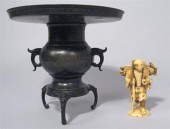 Japanese ivory okimono and mixed metalst
[more like this]
Japanese ivory okimono and mixed metalst
[more like this]
-
 A Carved Ivory Okimono Carved ivory okim
[more like this]
A Carved Ivory Okimono Carved ivory okim
[more like this]
-
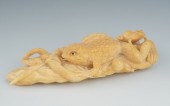 A Carved Ivory Toad Snake and Slug Okimo
[more like this]
A Carved Ivory Toad Snake and Slug Okimo
[more like this]
-
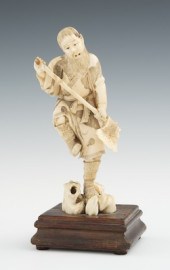 A Carved Ivory Okimono of a Man with an
[more like this]
A Carved Ivory Okimono of a Man with an
[more like this]
-
 A Japanese Bronze Okimono of a Howling T
[more like this]
A Japanese Bronze Okimono of a Howling T
[more like this]
-
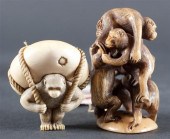 Japanese carved ivory okimono and netsuk
[more like this]
Japanese carved ivory okimono and netsuk
[more like this]
There are many more auction results available to our members...





